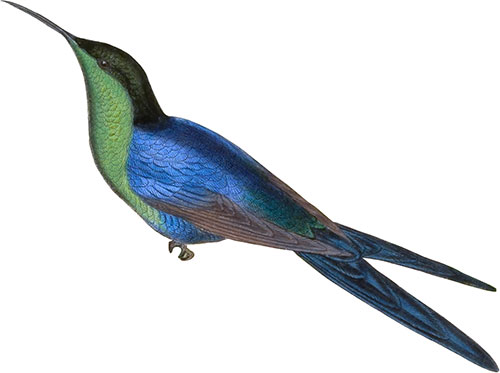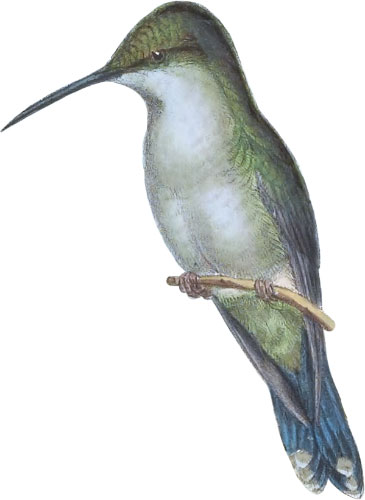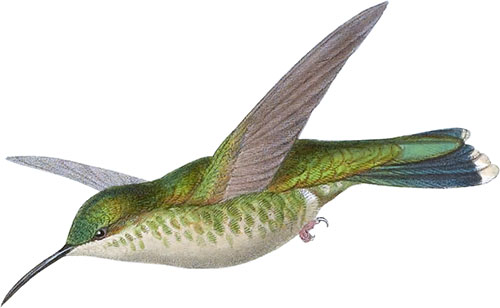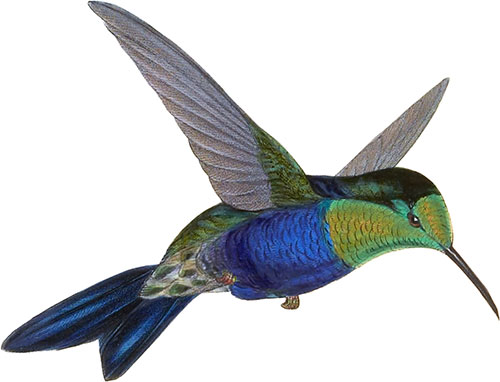Black-banded Wood-Nymph
Upper Amazon and Rio Napo.
There Is not perbaps a better defined group in the great family of Humming-Birds than that to which I have given the generic name of Thalurania, since all the species of which it is composed bear a very general resemblance to each other, and all are alike distinguished by an exceedingly beautiful style of colouring, of which blue and green are the prevailing tints; but so variously are these hues disposed in the several species, that each is readily distinguishable from the other.
The present bird (T. nigrofasciata) is rendered remarkably distinct from its congeners by the deep band of black which crosses the breast and separates the green of the throat from the rich blue of the abdomen. This band, which of course follows the curvature of the base of the throat-mark, is broad and conspicuous in some specimens, while in others it is almost obsolete, a circumstance which induced me at one time to believe that the banded and non-banded birds were two distinct species, and to give to the latter the name of virzdipectus; an examination, however, of a great number of specimens has since convinced me that both that term and nigrofasciata have reference to one and the same bird: viridipectus, therefore, which was proposed in 1848, two years after that of nigrofasciata, has been placed in the rank of a synonym.
The true habitat of this bird is the forests which border the upper parts of the rivers Amazon and Rio Negro; but it is also found in Bogota; and I have even received specimens in a collection from Quito; whence we may infer that it ranges over a vast extent of country, perhaps over the whole of the eastern dip of the Andes, of Ecuador, and Columbia.
The sexes present the usual differences in colour; the female being clothed in a most sombre livery, particularly on the under surface, a part which is so richly adorned in the male.
Throat lustrous green; edge of the shoulders and abdomen shining blue, separated from the green of the throat by a lunate band of black; head and back of the neck bronze; back and wing-coverts brownish green; wings purplish brown; tail dull steel-blue; bill black.
The female has the head, all the upper surface, and wing-coverts green; wings purplish brown; tail green at the base, passing into steel-blue at the extremity, and with a spot of white at the tip of the two outer feathers; all the under surface light brownish grey; bill black.
The figures are of the natural size. The plant is the Pilumna fragrans.
 Thalurania glaucopis
Brazilian Wood Nymph
Thalurania glaucopis
Brazilian Wood Nymph
 Thalurania Watertoni
Waterton’s Wood Nymph
Thalurania Watertoni
Waterton’s Wood Nymph
 Thalurania furcata
Cayenne Wood-Nymph
Thalurania furcata
Cayenne Wood-Nymph
 Thalurania refulgens
Refulgent Wood-Nymph
Thalurania refulgens
Refulgent Wood-Nymph
 Thalurania Tschudii
Tschudi’s Wood-Nymph
Thalurania Tschudii
Tschudi’s Wood-Nymph
 Thalurania venusta
Veraguan Wood-Nymph
Thalurania venusta
Veraguan Wood-Nymph
 Thalurania Columbica
Columbian Wood-Nymph
Thalurania Columbica
Columbian Wood-Nymph
 Thalurania verticeps
Green-crowned Wood-Nymph
Thalurania verticeps
Green-crowned Wood-Nymph
 Thalurania Eriphyle
Brazilian Wood-Nymph
Thalurania Eriphyle
Brazilian Wood-Nymph
 Thalurania? Wagleri
Wagler’s Wood-Nymph
Thalurania? Wagleri
Wagler’s Wood-Nymph
 Thalurania hypochlora
Citado Wood-Nymph
Thalurania hypochlora
Citado Wood-Nymph
 Thalurania jelskii
Jelski’s Wood-Nymph
Thalurania jelskii
Jelski’s Wood-Nymph
 Thalurania furcatoides
Para Wood-Nymph
Thalurania furcatoides
Para Wood-Nymph
Featuring all 422 illustrated species from John Gould’s A Monograph of the Trochilidæ, or Family of Humming-Birds arranged by color.